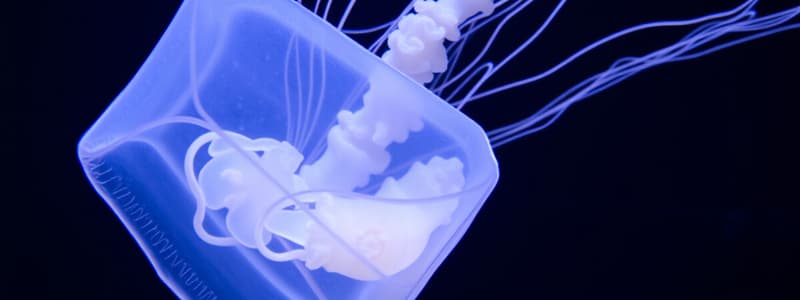Podcast
Questions and Answers
Why is it called box jellyfish?
Why is it called box jellyfish?
The bell is box-shaped.
It has similar morphology with what group?
It has similar morphology with what group?
Scyphozoans
What makes Cubozoa different from scyphozoans?
What makes Cubozoa different from scyphozoans?
Arrangement of their tentacles
How are their tentacles arranged?
How are their tentacles arranged?
In some cases, what may the digestive system do?
In some cases, what may the digestive system do?
What is the arrangement of the nematocyst and what is the purpose of that arrangement?
What is the arrangement of the nematocyst and what is the purpose of that arrangement?
What do Cubozoans have that forms unusual eyes?
What do Cubozoans have that forms unusual eyes?
Why can cornea, lens, and retina be called true organs?
Why can cornea, lens, and retina be called true organs?
How many eyes do Rhopalia have and for what purpose?
How many eyes do Rhopalia have and for what purpose?
Study Notes
Box Jellyfish Overview
- The bell of box jellyfish is uniquely shaped like a box, contributing to their common name.
- Box jellyfish are classified under the class Cubozoa.
Morphological Similarity
- Cubozoans share similar morphology with scyphozoans, another class of jellyfish.
Tentacle Arrangement
- The arrangement of tentacles distinguishes cubozoans from scyphozoans, providing them with unique hunting capabilities.
Tentacle Structure
- Tentacles are attached to muscular pads called pedalia located at the corners of the square canopy, allowing for effective locomotion and feeding.
Digestive System
- In certain instances, the digestive system may extend into the pedalia, affecting how cubozoans digest their prey.
Nematocyst Configuration
- Nematocysts are arranged in a spiral configuration along the tentacles, enhancing their ability to subdue and capture prey effectively.
Eye Structure
- Cubozoans possess complex eyes made up of cornea, lens, and retina, showcasing advanced visual systems.
True Organs
- The eye components—cornea, lens, and retina—are considered true organs due to their formation from multiple interactive tissues.
Rhopalia and Vision
- Cubozoans have three sets of eyes within their Rhopalia, providing them active and effective vision crucial for hunting.
Studying That Suits You
Use AI to generate personalized quizzes and flashcards to suit your learning preferences.
Description
Dive into the fascinating world of Cubozoa, commonly known as box jellyfish, with these flashcards. Explore their unique morphology, including the box-shaped bell and distinctive tentacle arrangement. Perfect for biology enthusiasts wanting to learn more about this intriguing marine creature.

